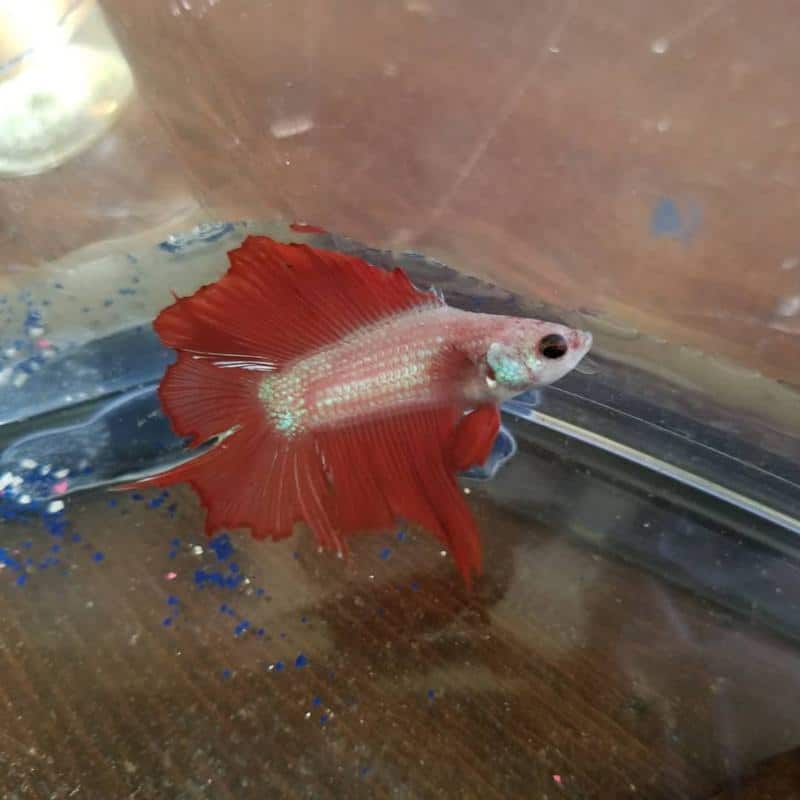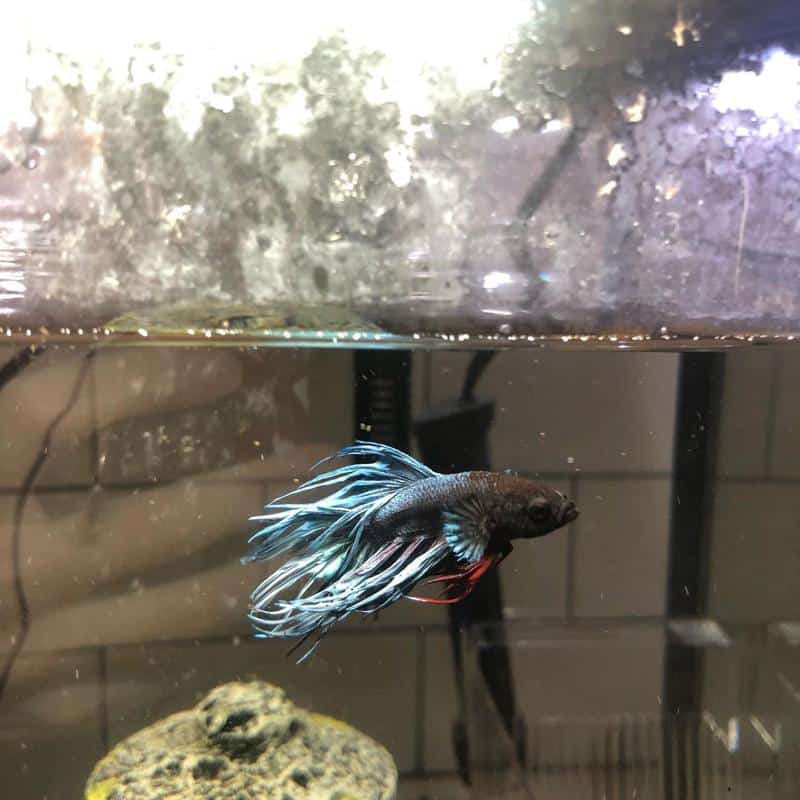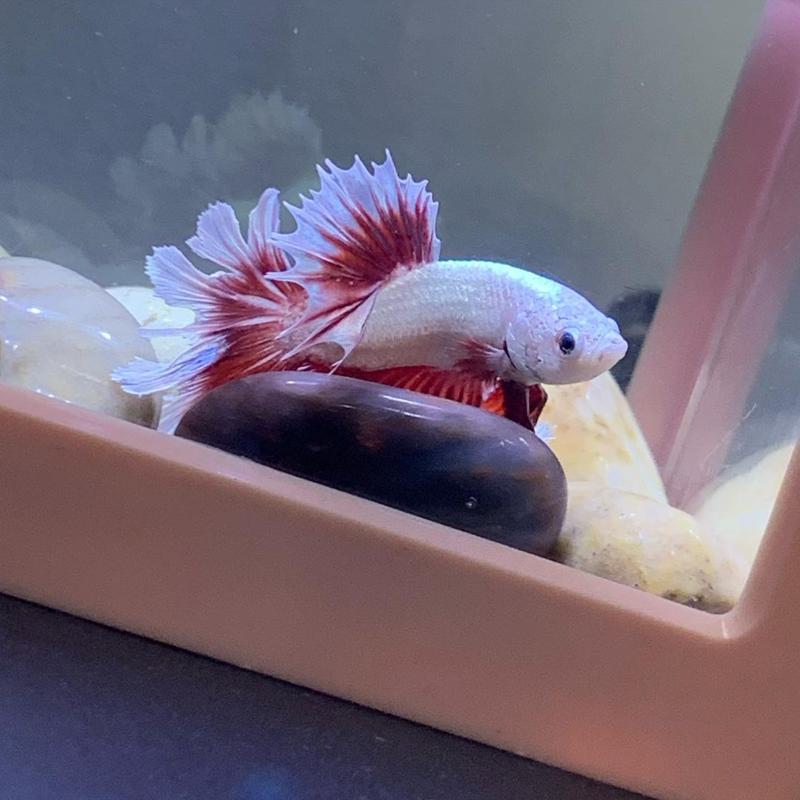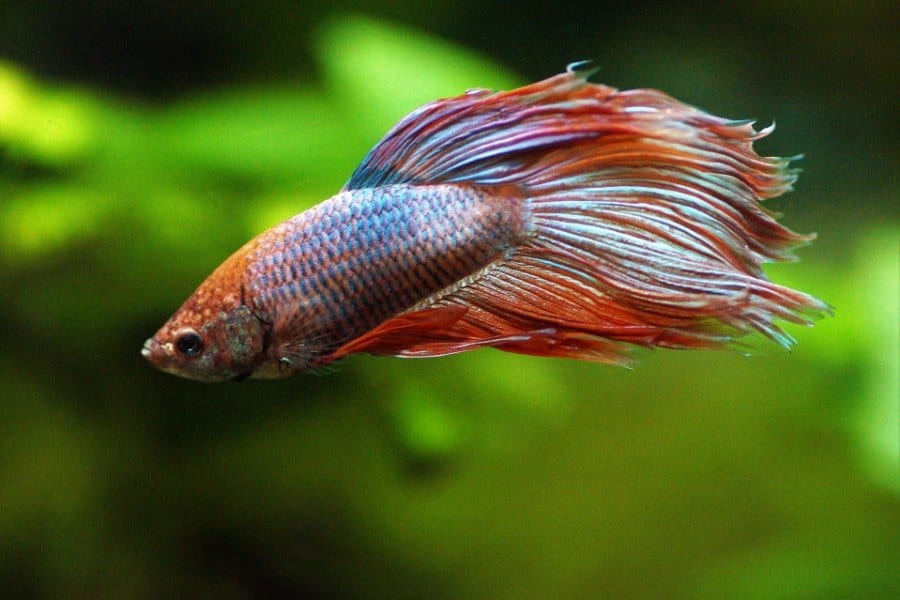Being responsible fish owners, it is your responsibility to make sure that your Betta fish stays healthy. With that, you might have observed your betta swimming sideways in the tank, which does not look right. But what’s causing this?
There are several possible causes for your Betta to swim in that way, and luckily, some of them are not that severe.
For instance, it can be as simple as the water flow being quite powerful for the fish. But it may possibly be a sign of a swim bladder disease.
This guide could come in handy if your fish is showing unusual behavior. We will share all the details related to swim bladder disease and other symptoms and reasons that are responsible for this.
Why Is My Betta Fish Swimming Sideways?

It is not normal for a betta fish to swim sideways all the time. It could be alarming since this may indicate a serious medical problem, especially a swim bladder infection.
But, sometimes, your fish might also have problems due to other factors. Following are a few examples.
Unclean Water
Examine the water to see how clean and pure it is. If you haven’t maintained the tank well, then your fish will definitely swim sideways.
Bettas are extremely susceptible to sudden water changes and may get stressed even with a minor adjustment. Because of that, you can notice that they tend to float sideways.
Bad Water Parameters
You could purchase a water testing kit, for example, the API Freshwater Test Kit, to evaluate the water conditions in your aquarium. It will provide you with all the information you require regarding the water condition in your aquarium.
Check to see if the pH, ammonium, and nitrate concentrations all fall under the recommended limits for Bettas. Bettas require a pH range of 6.5 to 7.5, with ammonium and nitrate levels of 0 ppm.
You must act right now to address any issues with your water conditions. Cleaning and changing the water of your aquarium should be your top priority.
To get rid of any contaminants present in the aquarium water, you must also think about purchasing a water conditioner. The Seachem Prime Freshwater Conditioner is an excellent choice.
Incorrect Water Temperature
You should also monitor the water temperature in your aquarium. Freshwater fish like bettas require warm water. Bettas enjoy water temperatures ranging from 76 to 82 degrees Fahrenheit because these freshwater species are acclimated to cozy temperatures.
If your aquarium water is extremely chilled, then your pet fish might swim in an abnormal way. Bettas could become stressed when they are exposed to freezing water. You must increase the water temperature of your aquarium to address this issue. It is possible using a heating device such as the Aqueon Tank Heater.
Swim Bladder Disorders
Swim bladder problem is among the most prevalent culprits of bettas swimming sideways. Bettas as well as other species could be affected by infectious diseases. If you suspect that your Betta has swim bladder illness, you must act quickly to address the issue.
What Is Swim Bladder Disease?
The swim bladder is a special organ that allows bettas to hover both laterally and sideways in the tank. They float in the water because of this gas-filled cushion, which is found in their belly.
A small pipe connects the swim bladder to its stomach. This pipe permits bettas to release extra gases through their swim bladder in order to keep their stability.
But, occasionally, this mechanism malfunctions, and Bettas may produce abnormal gases in their swim bladders. As a result, they could swim sideways and hover strangely to the surface.
Bettas floating laterally is the most noticeable sign of swim bladder illness. There are several more signs you should watch out for, such as:
- Floating on the top layer
- Sliding to the aquarium’s base
- Having an inflamed stomach
- spine with a curved S pattern
- Having trouble swimming
- Moving quickly or softly when swimming
If your pet exhibits either of these signs, it is most certainly suffering from swim bladder disorder. It’s important to take action right away and keep an eye out for symptoms since this condition could be dangerous if left undiagnosed. Here’s a video of a fish experiencing swim bladder disease: https://www.instagram.com/p/CIdw7BphvTx/
Causes of Swim Bladder Disease

Swimming bladder disease could be caused by a variety of other conditions. The most prevalent ones are as follows:
Ingesting Air
When they need to breathe, Betta fish often swim to the top surface. Oftentimes they do something like this unintentionally when eating. Sometimes they actually plan to inhale air to receive more oxygen. It is the way they breathe.
They are capable of doing this because they possess a unique organ that makes them labyrinthine species, particularly if the freshwater cannot provide them with sufficient oxygen.
However, even though bettas occasionally have to breathe, swallowing excessive air could be harmful.
While it’s undoubtedly safe when done in moderation, excessive air might cause swelling in a fish’s swim bladder. This swelled-up stomach is called a swim bladder illness.
Constipation
Constipation affects more than just people. It’s likewise a major issue for species such as Bettas. Constipation is also a prevalent reason for swim bladder illness.
Bettas experiencing constipation may have difficulty passing feces. It may result in bloating of the gastrointestinal, which exerts strain on their swim bladder.
It may be challenging for Betta to release gases from its swim bladder due to the trains from the swollen gut. Due to this, they could get swimmer bladder illness from having extra gas inside their gut.
Infections
Swim bladder problems in Bettas could be caused by microbial or antiviral diseases. Since infections may harm Bettas in a variety of different ways in addition to swim bladder illness, this is quite alarming.
Microbial diseases are the prevalent cause of swimbladder illness. These involve the bacterium Pseudomonas, Columnare, and Aeromonas. Parasites might possibly be on the list.
Bettas housed in unsanitary circumstances or in dirty water usually get these diseases. Therefore, if your pet is experiencing some microbial infection, then there are chances that your tank water is not clean.
Betta is susceptible to fungal attacks that impair its swim bladder. For example, the infection identified as betanodavirus affects both aquatic and marine species and can induce a disease referred to as viral neurological necrotic (VNN) in Bettas.
This virus affects the neurological network of the Betta fish and could result in overinflated bladders, which may also result in swim bladder illness. However, it goes without saying that if your pet has this illness, you’ll have to deal with additional issues than simply their gall bladder.
Red markings on a Betta’s belly or tail are probably the most prevalent sign of an illness. Consult your vet if your notice such stripes on your pet.
Tumors
Betta fish are susceptible to tumors in the same way as people are. They may develop them in many areas throughout their body, somewhat like humans. The caudal fin of Betta fish usually develops tumors, particularly if they have extremely long fins.
Bettas may get tumors behind their gall bladder on extreme occasions. Bettas with these tumors may experience paddling difficulties or may begin to move in an odd manner. Sadly, you can not treat this tumor and only give appropriate care and attention to your betta fish.
Although bettas with tumors may potentially survive for several weeks or even a year, if you notice that their standard of living is already being compromised, you could think about either having them put to rest at the veterinarian’s office or by yourself.
Trauma
A swim bladder infection may also be brought on by abdominal trauma in fish. For instance, throwing or disturbing a Betta might trigger its swim bladder to burst. Naturally, Bettas finds it challenging to move as a result.
Bettas could suffer abdominal and swim tract injuries if they consume anything too large for them. Bettas who have had gastrointestinal operations could develop swim bladder disease as a consequence of the treatment.
How Do You Cure Or Treat Swim Bladder Disease?

Swim bladder illness can be treated in a variety of ways:
Give Them Better Food
Providing Bettas diets rich in proteins may assist to cut down the amount of air that builds up in their swimming sacs. A protein-rich diet like seawater shrimp, duckweed, and blackworms may assist Bettas in discharging air from their gall bladder.
It’s necessary to keep in mind that feeding high-protein meals to Bettas must only be done occasionally. You must resume offering Bettas their normal food as soon as they are healthy again after developing swim bladder illness.
It is due to the fact that high-protein meals are already packed with fat; therefore, Bettas that consume excessive fat could become obese.
Related: How Often & How Much To Feed Betta Fish?
Change the Water
Swim bladder illness in your pet may be brought on by unclean water in their aquarium. Therefore, changing 20% of the water weekly can keep your tank clean and hygienic.
Cleaning the stones and decorative items in the aquarium is another important step. By doing this, you may eliminate any germs or organisms that might be responsible for your Betta’s swimming bladder condition.
It’s crucial to utilize a water purifier whenever you change the water in your aquarium. It would assist in getting rid of any dangerous toxins in the environment that might be harming your Betta.
Additionally, ensure that the aquarium water has a similar temperature to the animal’s body. Swim bladder illness could also occur if the temperature is extremely warm or freezing.
Add Epsom or Aquarium Salt To The Tank
Bettas with swim bladder illness may benefit from Epsom salt or aquarium salt. Bettas will feel better relatively fast since the salt may assist them to release any extra air from their gall bladder. Just add 1 tsp of Epsom salt per gallon of tank water.
We advise using an isolation container each time you need to provide the prescription to your pet, despite the claims of some that Epsom salt may be used directly in an aquarium without harming animals or plants.
However, you must always use Epsom salt as a short-term solution. You must take your Betta out of the isolation container when they have overcome swim bladder illness, then reintroduce them to their group.
Use Antibiotics
Antibiotic treatment may assist in treating the inflammation and easing the discomfort of the condition if a microbial infestation is a reason for a swim bladder disorder.
When treating Bettas experiencing swim bladder illness, these antibiotic drugs could be used:
- Tetracycline
- Kanamycin
- Neomycin
- Nitrofurazone
Antibiotics can only be used as the very last option. They may eliminate both harmful and beneficial bacteria inside your aquarium, which is not good.
Please read the instructions or consult your vet on how to properly use the antibiotics.
Even though your pet appears to be doing better, it is recommended that antimicrobial therapy should be completed. It will assist in ensuring that the virus is totally eliminated.
Surgery
Bettas suffering from swim bladder illness may require surgery in certain situations. Normally, the Betta will only require this when its swim bladder condition is being caused by an obstruction in its gastrointestinal tract.
Surgery is an extremely harmful treatment; therefore, it is essential to ensure that the operation is highly necessary before proceeding.
Also Read:
- Betta Fish Popeye: Early Signs, Treatment, & Care
- Betta Fish Laying on Bottom of Tank
- Fish at Bottom of Tank: Why & Solutions
- Why Is My Betta Fish Turning White (Losing Color)?
- Why Do My Fish Keep Dying?
- Betta Fish Behaviors Before Death
- Why Is My Fish Swimming in Circles?
- Why Your Betta Fish Is Not Eating
- Betta Fish Flaring
FAQs
Can Swimming Sideways Be Dangerous to Your Betta?
The illness’s underlying causes would determine the disease’s intensity and the likelihood of death. The odds of the betta recovering quickly are quite good if the problem is brought on by poor nutrition or constipation. But, if the infection is caused by microbiological or parasitic diseases, the odds of survival are low.
Is Swim Bladder Disorder Transferable?
No, bettas don’t transfer swim bladder infection to other bettas. Although, it may spread unpredictably and infect other species in the aquarium if a pathogen or bacterial is the condition’s primary cause. Therefore, try to keep the aquarium water clean.
Conclusion
It could be unsettling to see a Betta fish floating sideways. Without knowing what’s causing it, you can not provide proper treatment to your betta fish.
We hope that we have provided you with the possible reasons why your pet is behaving this way. Make sure to address the problem as soon as possible to avoid severe infections.
